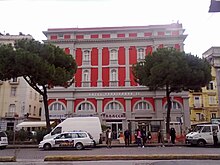
Aversa is a city and comune in the Province of Caserta in Campania, southern Italy, about 24 km north of Naples. It is the centre of an agricultural district, the Agro Aversano, producing wine and cheese. Aversa is also the main seat of the faculties of Architecture and Engineering of the Università degli studi della Campania "L. Vanvitelli". With a population of 52,974 (2017), it is the second city of the province after Caserta.
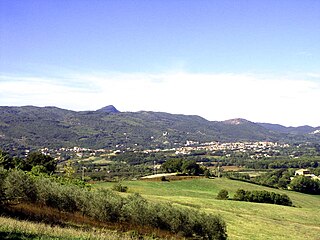
The province of Caserta is a province in the Campania region of Italy. Its capital is the city of Caserta, situated about 36 kilometres (22 mi) by road north of Naples. The province has an area of 2,651.35 square kilometres (1,023.69 sq mi), and had a total population of 924,414 in 2016. The Palace of Caserta is located near to the city, a former royal residence which was constructed for the Bourbon kings of Naples. It was the largest palace and one of the largest buildings erected in Europe during the 18th century. In 1997, the palace was designated a UNESCO World Heritage Site.

Caserta is the capital of the province of Caserta in the Campania region of Italy. An important agricultural, commercial, and industrial comune and city, Caserta is located 36 kilometres north of Naples on the edge of the Campanian plain at the foot of the Campanian Subapennine mountain range. The city is best known for the 18th-century Bourbon Royal Palace of Caserta.

Alife is a town and comune in the Province of Caserta (Campania), Italy. It is located in the Volturno valley, and is a flourishing centre of agricultural production. The comune was formerly inhabited by Arbëreshë and Jewish communities, who have since assimilated.
Macerata Campania is a comune (municipality) in the Province of Caserta in the Italian region Campania, located about 25 kilometres (16 mi) north of Naples and about 6 kilometres (4 mi) west of Caserta.

Piedimonte Matese is a comune (municipality) in the Province of Caserta in the Italian region of Campania, located about 82 km north of Naples and about 40 km north of Caserta.

Miano is a suburb of Naples, Italy, with a population of around 26,000.

Piscinola, or Piscinola-Marianella, is a northern suburb of Naples, Italy, with a population of ca. 20,000. It is bordered to the north by the Scampia district, north-west with the municipality of Mugnano of Naples, on the west by the Chiaiano district, to the south with the district of San Carlo all'Arena and east with the district Miano.
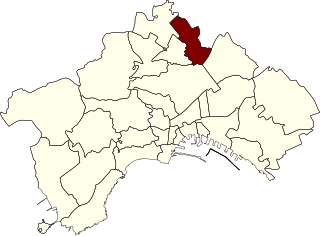
Secondigliano is a modern suburb in the north of Naples, Campania, Italy. It is part of the 7th municipality of Naples, along with the suburbs of Miano and San Pietro a Patierno.
The Rome–Cassino–Naples railway is a railway in Italy, the first of the three existing railway lines between the capitals of Latium and Campania to be opened when it was completed by the Società per le strade ferrate romane in 1863. The line is now fully electrified at 3 kV DC. It is now mainly used by regional trains, some trains to and from the Adriatic coast and a few night trains. The Rome–Naples high-speed railway line generally follows the same route.
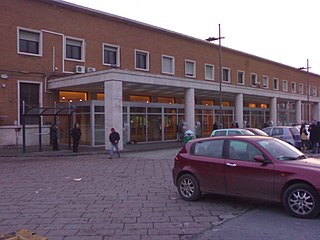
Caserta railway station serves the city and comune of Caserta, in the region of Campania, southern Italy. Opened in 1843, it forms the junction between the Rome–Cassino–Naples railway and the Naples–Foggia railway.

The Naples tramway network is located within the city and comune of Naples, in the region of Campania, southern Italy. In operation since 1875, the network has waxed and waned in size and vitality over the years, and is now growing once again. It is now 11.8 km (7.3 mi) long, and comprises three routes, known as lines 1, 2 and 4.

Most narrow-gauge railways in Italy were built with Italian metre gauge, which is actually 950 mm because historically the Italian track gauge was defined from the centres of the rail instead of the internationally accepted method of measuring the gauge from the inside edges of the rails. Several metre-gauge lines were built in northern Italy.

The Salerno–Reggio Calabria railway is the most important north–south railway connection between Sicily, Calabria and the rest of the Italian peninsula. It forms the southern section of Corridor 1 of the European Union's Trans-European high-speed rail network, which connects Berlin and Palermo. Its southern part, between Rosarno and San Lucido is also used as an RFI freight route between the Port of Gioia Tauro and the Adriatic railway.

Naples Metropolitan Railway service are two independent companies that operate a commuter rail system in Naples. The first one, Trenitalia, operates line 2 from Pozzuoli Solfatara to Gianturco station in East of Naples. The other one, EAV, operates the Circumvesuviana, Cumana and Circumflegrea. In Italy, Naples is the only city possessing two independent metropolitan railway service companies.
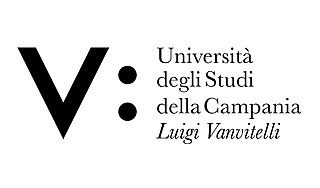
The University of Campania Luigi Vanvitelli is an Italian research university founded in late 1991. Its main seat is in Caserta, but its academic departments are also located in a series of historic and contemporary buildings in Naples, Aversa, Capua and Santa Maria Capua Vetere.
The Matese Legion was a group of 240 Italian volunteers that joined Giuseppe Garibaldi in the war for Italian unification in 1861. It was formed in Piedimonte D'Alife, now called Piedimonte Matese, in June 1860, and was officially established on 25 August of the same year. Membership in the legion gradually declined, and it broke apart on 3 March 1861.
The Ente Autonomo Volturno S.r.l., also known by the acronym EAV, is a company that operates in the sector of public transport by road, rail and cableway, in the Campania Region.
Di Vittorio will be a station on Line 1 of the Naples Metro and on Line 11 of the railway network managed by EAV. It is located in the Secondigliano district, between Piazza Giuseppe Di Vittorio and Viale Comandante Umberto Maddalena.
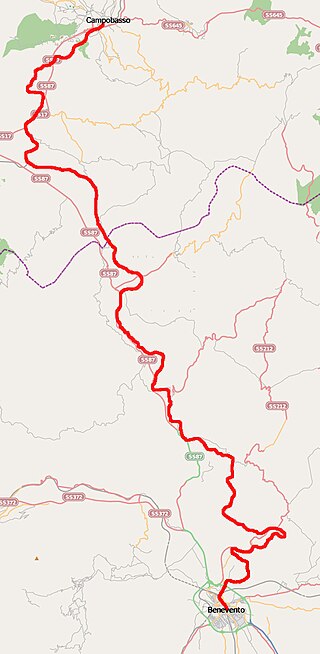
The Benevento–Campobasso railway is a secondary Italian railway line in Campania and Molise connecting Benevento with Campobasso of Samnium. Planned as an alternative to the Naples–Foggia railway to connect the Tyrrhenian Sea to the Adriatic Sea, but later deemed very slow and therefore uncompetitive, it has never been affected by large volumes of traffic.
